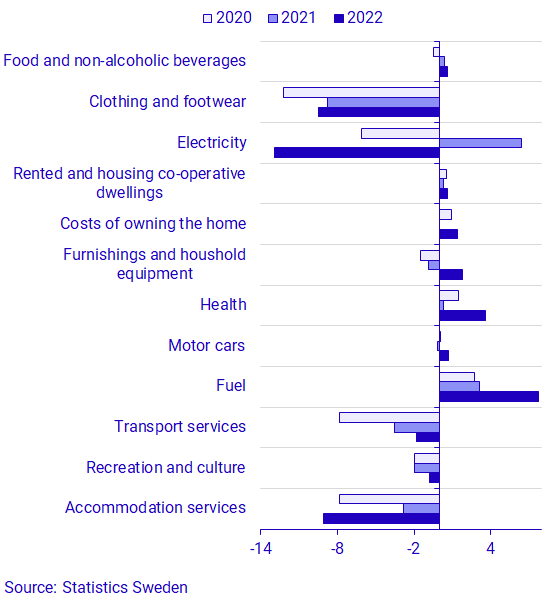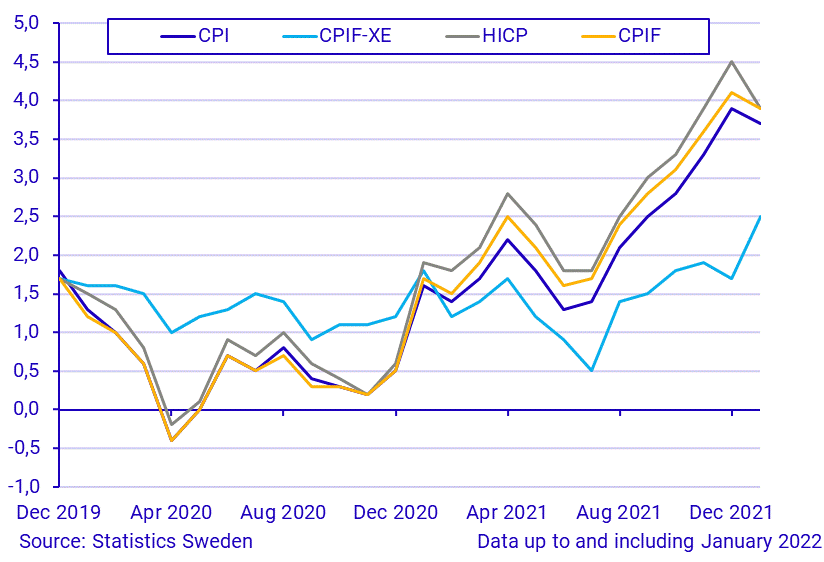Consumer Price Index (CPI), January 2022
Inflation rate was 3.9 percent in January
Statistical news from Statistics Sweden 2022-02-18 8.00
The CPIF (Consumer Price Index with fixed interest rate) 12-month inflation rate was 3.9 percent in January 2022, down from 4,1 percent in December. On a monthly basis, the inflation rate according to the CPIF fell by 0,5 percent between December and January.
"Electricity prices fell in January, after several months of increased prices, which contributed to a decreased inflation rate,” says Carl Mårtensson, statistician at Statistics Sweden.
In brief
| Index Numbers |
Monthly changes, percent |
Annual changes, percent |
|
|---|---|---|---|
| CPI (1980=100) | 350.56 | ‑0.5 | 3.7 |
| CPIF (1987=100) | 230.01 | ‑0.5 | 3.9 |
| CPIF-XE (1987=100) | 213.97 | 0.1 | 2.5 |
- Electricity prices fell in January, however, it has increased over the last 12 months
- Prices fell for clothing, footwear, transport services and accommodation services in January
- Prices rose for fuel, motor cars, furniture and health services in January
- The inflation rate according to CPIF excluding energy increased from 1.7 percent in December 2021 to 2.5 percent in January 2022, which was the highest notation since 2009
- The basket effect affected the monthly rate in January 2022 by -0.03 percent.
Electricity prices fell
The CPIF fell by 0.5 percent from December to January. In the corresponding period a year ago, the CPIF decreased by 0.3 percent.
The main contribution to the CPIF monthly rate in January came from decreased prices on electricity. There were also a seasonal decline in prices on clothing and footwear, where mainly clothing contributed to the downward pressure. Prices also fell for accommodation services, transport services, recreation and culture.
Fuel prices increased in January where diesel contributed most. Prices in January increased for motor cars, health services and food and non-alcoholic beverages. There were also increased prices for furnishings and household equipment where mainly furniture and household utensils contributed.
In January, increased housing costs and fees for rented and housing co-operative dwellings was noted.
The basket used to calculate the CPIF is updated in January each year. Obsolete goods and services are removed, and new items are added. In addition, the weights for all goods and services in the basket are updated. The total effect of the updated composition of the basket and new weights is called the “basket effect”. In January 2022, the contribution of the basket effect to the monthly change in the CPIF was -0.03 percent.
Any methodological changes in the CPIF are also introduced in January. The document from the publication in December has been updated with a section on updated weights in electricity, owner-occupied housing. For further information on changes introduced ahead of 2022, follow the link under “Changes in 2022”.
The Swedish government has suggested a special measure to compensate households for high electricity prices. Statistics Sweden has decided not to take the proposed compensation into account in the calculation of the CPI and related measures of consumer side inflation, including the CPIF and the HICP. For further information, follow the link under “Treatment of the special measure to compensate for high electricity prices”.
The table below shows changes on a monthly basis and contributions to the CPIF based on the goods and services that had the greatest impact on the CPIF in January 2022. The results are presented by COICOP category. COICOP refers to the United Nations classification of household consumption expenditure.
| Category (Coicop) | Monthly changes, percent |
Contribution to CPIF Monthly change, percentage points |
|---|---|---|
| Food and non-alcoholic beverages (01) | 0.6 | 0.1 |
| Clothing and footwear (03) | ‑9.5 | ‑0.4 |
| Electricity (04.5.1) | ‑12.9 | ‑0.9 |
| Rented and housing co-operative dwellings: rent incl. heating (04.S) | 0.6 | 0.1 |
| Costs of owning the home (04.x) | 1.3 | 0.1 |
| Furnishings and houshold equipment (05) | 1.8 | 0.1 |
| Health services (06) | 3.6 | 0.1 |
| Motor cars (07.1.1) | 0.7 | 0.1 |
| Fuel (07.2.2) | 7.7 | 0.2 |
| Transport services (07.3) | ‑1.8 | ‑0.1 |
| Recreation and culture (09) | ‑0.8 | ‑0.1 |
| Accommodation services (11.2) | ‑9.1 | ‑0.1 |

Seasonal patterns and temporary price changes
Price changes on goods and services may be seasonal or temporary. The figure above shows the monthly changes this year and in the two most recent years for the goods and services with the largest impact on the CPIF monthly change.
Electricity prices fell notably in January 2022 which can be compared with January 2021 when it rose. For January 2020, electricity prices fell but not as much as in January 2022.
Clothing and footwear showed a price decrease in January 2022, which was also noted for the corresponding month in 2021 and 2020. Accommodation services, transport services as well as goods and services within recreation and culture did also note decreased prices in January for the third year in a row.
Fuel prices rose in January 2020 and 2021, however, prices rose even more in January 2022. Other services that rose in price in January 2022 for the third year in a row were health services and fees for rented and housing co-operative dwellings.
Other goods that have had varied monthly price changes in the last three years were food and non-alcoholic beverages, costs of owning the home, furnishings and household equipment and motor cars.
Contributions to the inflation rate in January
The inflation rate according to the CPIF, that is, the change in the CPIF over the past 12-month period, was 3.9 percent in January 2022, down from 4.1 percent in December.
The rate of inflation was mainly affected by higher electricity prices in the last 12 months. However, the annual effect was not as high in January as in December which is contributing to the lower inflation rate in January.
There were price increases for fuel and motor cars which contributed to maintain a positive inflation rate. Prices also increased for food and non-alcoholic beverages, restaurant and hotel services and furniture. In addition, costs of owning the home and fees for rented and housing co-operative dwellings increased in January.
The inflation rate according to the CPIF excluding energy was 2.5 percent in January, down from 1.7 percent in December.
| Category (Coicop) | Yearly change, percent | Contribution yearly change CPIF percentage points |
|---|---|---|
| Food and non-alcoholic beverages (01) | 1.9 | 0.3 |
| Electricity (04.5.1) | 23.2 | 0.8 |
| Rented and housing co-operative dwellings: rent incl. heating (04.S) | 1.6 | 0.2 |
| Cost pf owning the home (04.x) | 6.7 | 0.5 |
| Furniture (05.1) | 8.0 | 0.2 |
| Motor cars (07.1.1) | 4.6 | 0.2 |
| Fuel (07.2.2) | 33.2 | 0.7 |
| Restaurants and hotels (11) | 4.2 | 0.3 |
Other measures of inflation
Statistics Sweden calculates different inflation measures for different purposes. The CPIF is the Riksbank’s target variable, while the CPI is the measure used for purposes of compensation.

Changes in 2022
Some changes in the production of the Consumer Price Index will be introduced from 2022. The document from the publication in December has been updated with a section on updated weights in electricity, owner-occupied housing. For further information, please see:
Treatment of the government’s proposition to compensate for high electricty prices
The Swedish government has suggested a special measure to compensate households for high electricity prices. Statistics Sweden has decided not to take the proposed compensation into account in the calculation of the CPI and related measures of consumer side inflation, including the CPIF and the HICP. For further information, follow the link under “Treatment of the special measure to compensate for high electricity prices”.
Treatment of the special measure to compensate for high electricty prices (pdf)
Definitions and explanations
The CPIF shows the same price trend as the CPI, but without the direct effects of a changed monetary policy. The CPIF is the Riksbank’s target variable for the inflation target.
The CPIF excluding energy (CPIF-XE) and the CPIF with constant tax (CPIF-CT) are two other measures of inflation produced by Statistics Sweden on behalf of the Riksbank. In the CPIF-XE, energy products are excluded from the CPIF, while in the CPIF-CT the taxes and subsidies associated with the products in the CPIF are kept constant.
The HICP (Harmonised Index of Consumer Prices) is produced by all EU Member States. This measure has a somewhat smaller coverage than the CPI and the CPIF, mainly because parts of households’ housing costs are omitted.
Next publishing will be
2022-03-14 at 8:00.
Statistical Database
More information is available in the Statistical Database
Feel free to use the facts from this statistical news but remember to state Source: Statistics Sweden.
